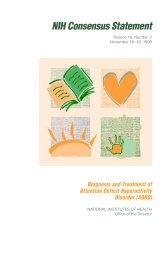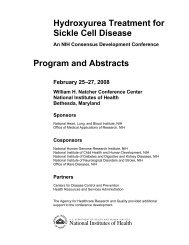Celiac Disease - NIH Consensus Development Program - National ...
Celiac Disease - NIH Consensus Development Program - National ...
Celiac Disease - NIH Consensus Development Program - National ...
Create successful ePaper yourself
Turn your PDF publications into a flip-book with our unique Google optimized e-Paper software.
Osteoporosis/FracturesThere were 11 articles that evaluated bone mineral density (BMD) in individuals with CDand 6 controlled studies that assessed the outcome of fracture. Most studies documented anincreased prevalence of osteopenia in newly diagnosed celiacs. One study found that femoralneck BMD was significantly lower in symptomatic celiacs. (2)In the majority of studies, a variable but significant increase in BMD was noted after1 year on a GFD. The issue of fracture prevalence in CD was controversial with some studiesfinding an increased rate of fractures and other studies not noting an increased risk. Difference inmethodologies including sample size, study populations, and ascertainment of fractures couldaccount for differences in fracture risk. The risk of fracture appeared to be highest prior to thediagnosis of CD. Moreno et al. found that the risk of fracture was not increased in subclinicaland silent cases of CD in contrast to symptomatic cases. (2) Additional population based fracturestudies in subpopulations of celiac individuals would help clarify risk of fracture.MortalitySeven studies evaluating mortality were included and the majority demonstrated anincrease in the overall mortality rate for CD when compared with the general population(SMR = ≥ 2). Mortality rate was increased with longer delays in diagnosis and poor compliancewith the GFD. Corraro et al. found that mortality was not increased when compared to thegeneral population in those with mild symptoms or those who were asymptomatic atpresentation. (3)ConclusionsBased on our literature review, the consequences of testing and identifying symptomaticCD patients can have a positive impact on patient relevant outcomes such as improved bodycomposition, nutritional status, bone mineral density, and fractures. This improvement is in partdue to the superior compliance that is seen in individuals with symptomatic CD. The data onconsequences are less clear for asymptomatic at-risk populations and individuals identifiedthrough population screening programs. Although some studies suggest a lower risk ofcomplications in asymptomatic individuals identified through screening, it is premature toconclude that the risks of complications are lower. At present, there is inadequate evidence fromthe published literature on the magnitude of the benefits and harms of screening the generalpopulation and the potential risks of undetected CD. Further research, including comprehensiveeconomic evaluations, are recommended to adequately address the consequences of screening inboth asymptomatic at-risk groups and the general population.References1. Canadian Coordinating Office of Health Technology Assessment (CCOHTA) Guidelines forEconomic Evaluation of Pharmaceuticals: Canada, 2nd edition, 1997.89







